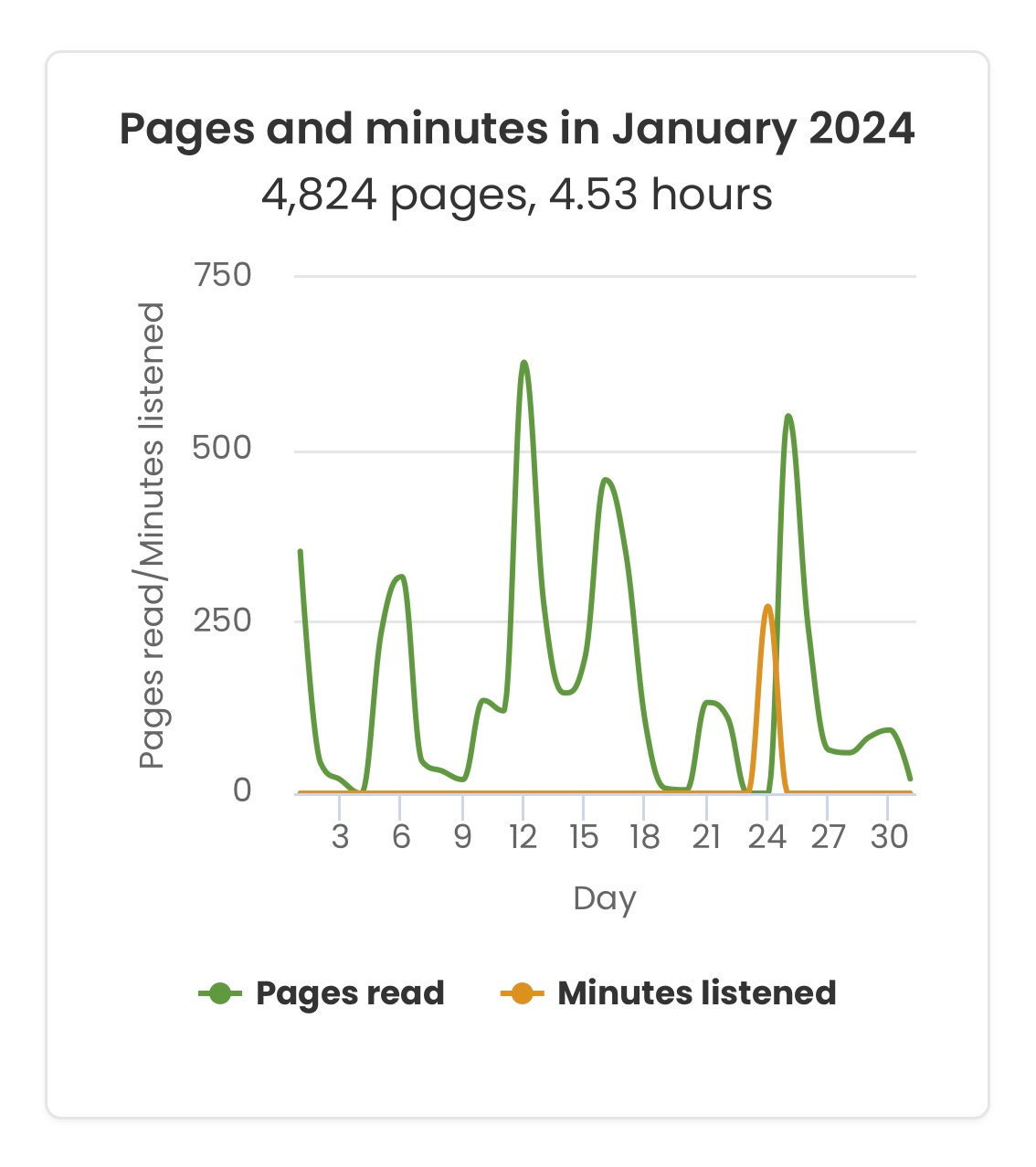On Craft #2: How reading daily changed how I think about consistency and moderation
And some thoughts on daily streak challenges and routines
For the month of January, StoryGraph launched a challenge that encouraged participants to read everyday. It could be one minute of an audiobook or an entire hour. A few pages of a book or the whole dang thing. However much was read was up to the reader, just as long as a book was picked up everyday in January.
For context, I don’t like the idea of an activity streak managed by lines of code that lack understanding of the human condition. For example, I never keep up with Peloton’s daily activity streak challenge but I will try to maintain a weekly activity streak because it’s realistic and accounts for days that I (*gasp*) just don’t want to do anything. One can be perfectly happy and healthy committing to an exercise routine that doesn’t require daily activity.
I know I could do a five-minute stretching class to get my lil’ checkmark and maybe warm up my hamstrings, but will my body get anything substantial out of it? At that point, am I approaching the app with a genuine desire to workout because it makes me feel good or am I opening it with a heightened commitment to maintaining my streak? What’s the motivator here? Of course, I don’t speak for every Peloton user, and frameworks with little flexibility are what some people need in order to really thrive and stick with something. However, knowing how I feel about daily streaks have deepened my understanding of what a healthy, intentional routine can look like for me.
On the other hand, I love how Duolingo approaches streak challenges. The expressive and somewhat passive aggressive owl, Duo, will remind me about my daily lessons but if I miss one, my streak is protected by what they call a “streak freeze”. Most users will have a couple of these to use and they can be acquired and replenished by using gems, which are earned after completing a lesson. This is literally why I’m a short week away from a 1,000-day streak and why completing at least one French, German, or Japanese lesson is part of my daily routine. I don’t even have to think about it! I just do it. It’s one of the few things that I’m consistent with on a daily basis. If I’m extremely busy or just not feelin’ it that day, I know a streak freeze will be there to hold down the fort and let me rest with the fact that I didn’t force myself to do something that I wouldn’t otherwise give my full attention.
Which brings me back to StoryGraph’s January Pages Challenge.
My traditional approach to reading looks like this: make a cup of tea, get warm and cozy, and sit down with a book for a good hour or two. More often than not, my brain tells me that if I can’t devote a solid chunk of time to reading (or anything creative, really) then I should just do something else instead for if I can’t give myself the time to slow down and focus on what I’m doing, should I really be doing it at all in that moment? Will it be a productive use of my time? Will I be glad that I read for five minutes or will I feel frustrated that I could’ve engaged with the book a bit more by reading another chapter or two? In this case, my concern is more oriented around moderation rather than consistency. I can pick up a book without any problem, but why do I feel like I need to finish it in two sittings?
These are the questions that swarm through my mind and while they’re completely valid and intriguing and sort of silly to think about, I wonder if I place too much weight on trying to analyze and answer them instead of just…reading (this is my Carrie Bradshaw moment).

So, how did turning the page at least once everyday in January go? Surprisingly well. I was fully intending to give up and say “to hell with it” but I stuck with it. In fact, I think it made me a slightly “better” reader. While I still value engaging with the text, it’s not something that keeps me from picking up a book when I only have 15 minutes to spare and might only read a small handful of pages. What I put into the experience is, on most occasions, what I’ll get out of it, and reading is no exemption to this.
Consistency and moderation are two things that I struggle with in all areas of my life, and this challenge convinced me that yes, I can do a little bit of something every single day and still feel like I’m engaging with it in ways that matter to me. Focusing on the fact that I prioritized reading everyday was more impactful than plowing through a book in two sittings. I made it a part of my daily routine, which not only brought me so much comfort but it built and sustained my reading momentum day after day. Much like with how I approach my Duolingo lessons, I can also just not read if I’m not feelin’ it. Coming from an all-or-nothing mindset, this is a pretty substantial realization to sit with and makes me think about what else in my life it could transfer to.

It’s easy to chalk everything up to, “Well, duh! Just read and stop thinking so much! It’s not that deep!” But I’d argue that it can be, especially when it dictates how I spend what free time I have at my disposal. When I remove all the hours of my day that are taken up by other things (e.g. getting adequate sleep, working, therapy and doctor’s appointments, etc.), what am I left with and how will I use that time to benefit me and what I need most? That’s what I want from my daily life. Not a filled-in circle on my Peloton app that confirmed I did something but rather committing to something consistently that brings forth meaningful engagement to fuel my mind, body, and soul. That’s where I want to be.
Well, that’s where I leave y’all today. I’m curious - is there a specific way in which you approach and engage with reading? Is this something that you also struggle with at times or have you managed to find some semblance of balance between it all? Leave me a comment and let me know. As always, thanks so much for reading! I appreciate y’all.
‘Til next time,
Where to find me: Instagram | YouTube | Pinterest | Goodreads | StoryGraph







I read every night on my Kindle before going to sleep, whether that's a page or several chapters, but I haven't been able to figure out getting myself into the habit of tracking that on Storygraph.